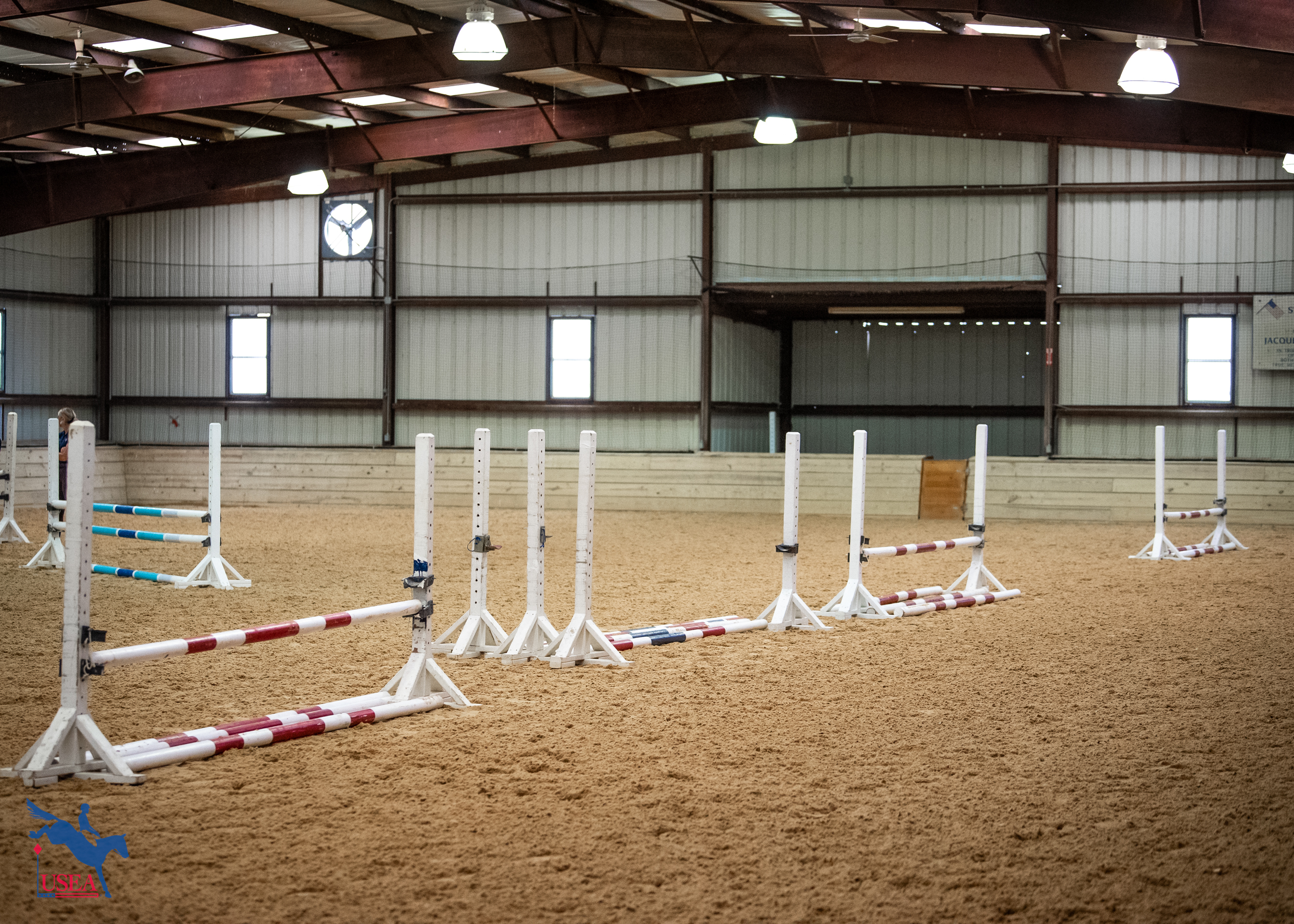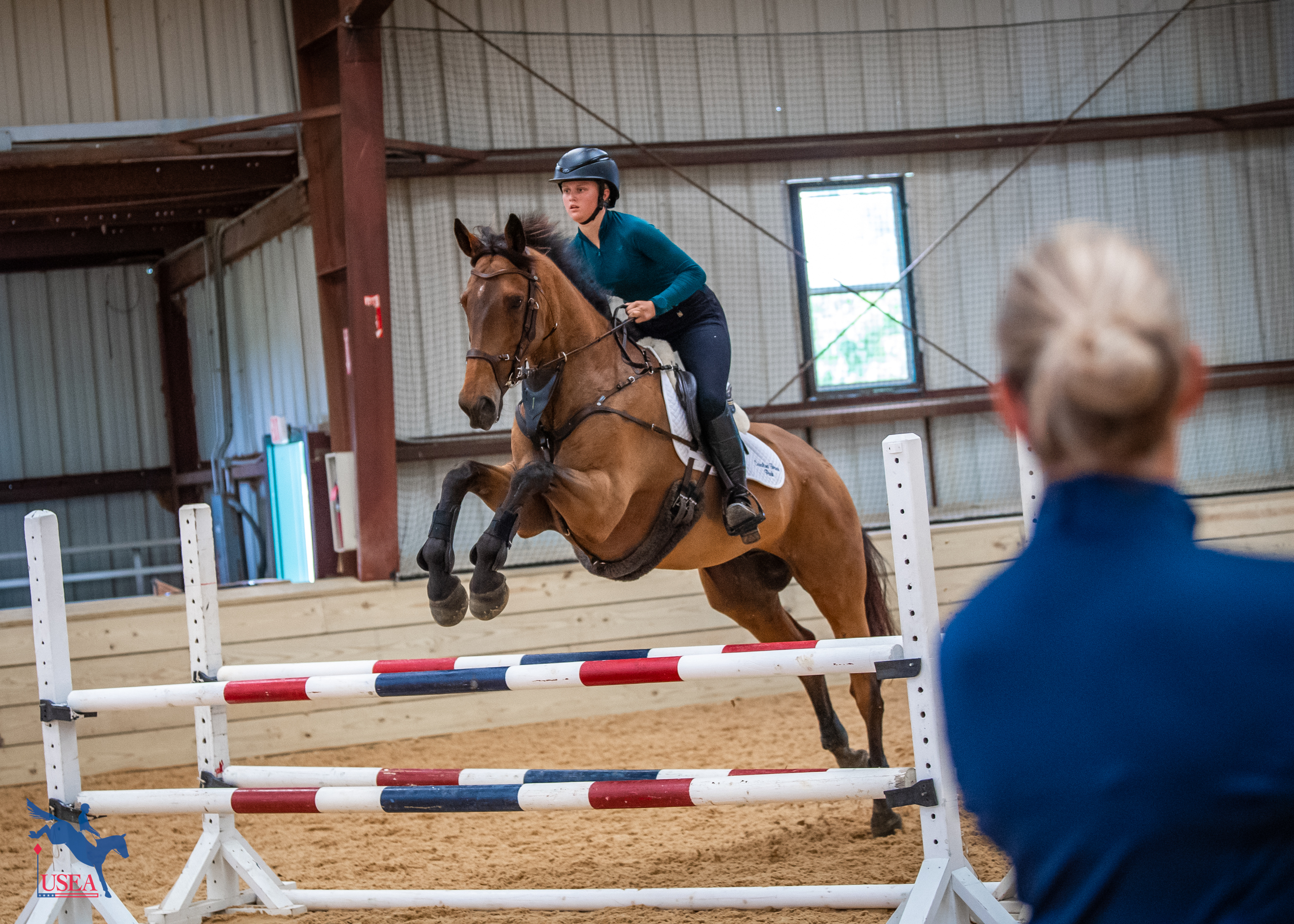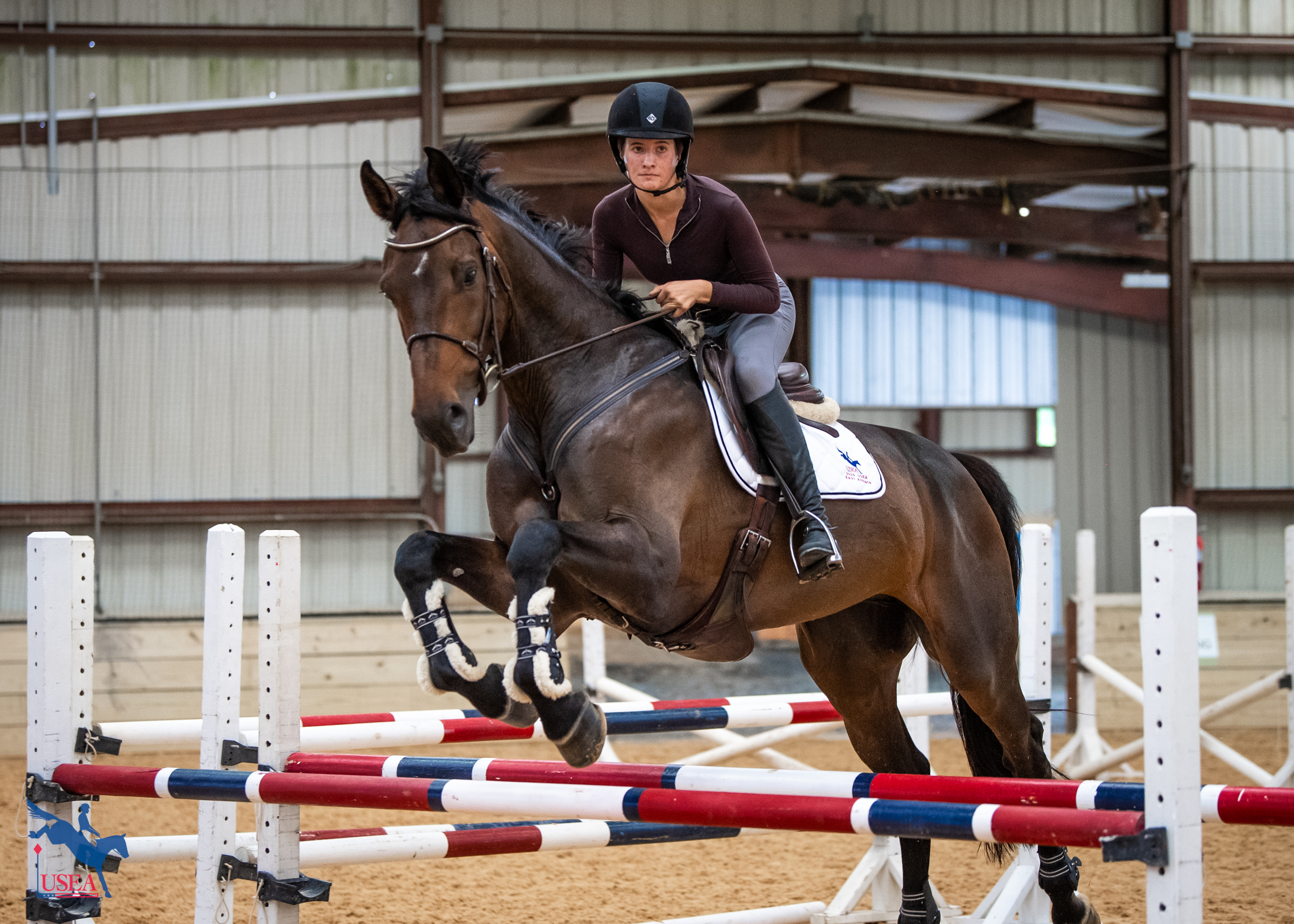Controlling the Canter on Day 2 of the USEA EA21 East I Clinic

Leesburg, Va.—June 18—The canter is always the most important piece when riding a course of fences, and after working hard on developing elasticity, suppleness, and engagement during yesterday’s dressage lessons, today’s 12 USEA Emerging Athlete Under 21 (EA21) riders got to put that to the test during the East Coast I clinic at Morven Park.
Under coach Bec Braitling’s guidance, four groups of three riders worked on keeping the correct canter and a strong position over fences in the tight confines of Morven’s indoor arena.
Braitling set up a few gymnastic exercises, including one that mimicked a cross-country question, and had riders working those exercises into a full course as the lessons progressed.
Riding in the indoor was a challenge by itself, because it makes riders think they’re going faster than they are.
“In here, [the horses] come back a little easier,” Braitling said. “So just understanding the environment that you're in and then training accordingly and setting distances accordingly.”
As each group warmed up, Braitling reminded them, eyes up, looking to what’s next. She emphasized that the lower leg is a rider’s base of support, no matter if you use a full or half seat position, and to work on opening and closing the hip angle to change balance depending on the type of jump. Position is key to influencing the horse, Braitling said. She asked riders to warm up in canter by going forward and coming back to test their horse’s elasticity and to make sure they were on the aids. She also advised doing that when picking them back up after a break.

“Check in. Does the horse feel laterally supple? Can we lengthen and compress?” she said, adding with a laugh, “I never want to hear clucking. Save your clucking for the Head of the Lake!”
Braitling is also a USEA Eventing Coaches Program (ECP) faculty member, and one of the key concepts taught in that program are the five rider responsibilities—direction, speed, balance, rhythm, and timing/distance, which she explained to the riders today.
“It's funny; it's so basic really, but then it's actually when all those things happen, it’s just easy every time. And you could see that with some of the riders today,” she said. “Our job is to be the best caretakers we can be to get them to a fence.”
After lots of work on 10-meter circles to lengthened gaits yesterday, some riders incorporated circles again in between fences to regain softness.
“I think what was cool was that some of the horses, on what we'd picked up on yesterday were able then to go back and do that today,” she said. “It was the 10-meter circles, especially—the canter, just trying to create that little better engagement. I will say I thought that everyone was quite strong on the flat, so it was good to see that carry over to today.”

Braitling’s first exercise, “thread the needle,” was quite challenging. While the fences started low, control was key as riders angled three fences on an ‘S’ bend about four to five strides apart and set with the standards 10’ apart on a line. The entire line was on the quarter line of the arena, giving riders very little space to bounce off the walls. Then they started to add in a triple bounce on a curve on the short side, a one-stride oxer and vertical, and a longer outside line with a “mystery distance” that Braitling wanted each rider to tailor to their horse.
“I think ultimately, [thread the needle is] an exercise that even a young horse can pick up,” she said. "I felt like it set the standard, or set the tone a little bit for them thinking, what's next? Trying to get that instinct straight away, right off the bat. You could see where they were caught out at times, and then it helped them straight away.”
For the “mystery distance” in the outside line, Braitling hoped it would cause riders to react and notice where they were in the line. It was also long enough that there was time to really change position and influence the horse to make a good jump out.
Riley Zgrebnak was participating in an EA21 clinic for the first time and was happy to have tips on controlling her position. “It’s been fun,” she said after her ride. “In general, [Braitling] focuses a lot on body position which is nice because I like to focus on that too. It’s been nice to fine-tune.”

“It's fun when you can compare everybody and see who notices early where they're at, who reacts, who is caught off guard, and then who can come around change that,” said Braitling. “It's really just repeating that process, again and again so it becomes second nature to react.”
Caitlin O’Roark has participated in the EA21 program for four years and appreciated the challenge of riding in the indoor for the jumping this year. As always, she said she’s learned a lot just from observing others. “It’s been awesome to watch everyone and see the different types of horses but also use the same fundamental skills we learned yesterday to transfer them into the jumping. Bec has done such a good job incorporating all the horses and riders into the same system and theory.”
Katherine Maroko, also a first-timer, enjoyed watching others as well, and added of today’s jumping, “it was a lot to do in a small space, so a lot of having to really focus on what’s happening every stride, but it was really useful, and I liked the way that we were focusing a lot of positioning of the horse and making sure they had the best chance possible to jump out of any scenario.”
The USEA’s EA21 clinics will continue next month. Click here for more information, and stayed tuned for more detailed schedules.
The USEA would like to thank Morven Park for hosting and Susie Beale for her work as on-site coordinator this week, as well as coach Bec Braitling for her excellent teaching.
East I | Morven Park Equestrian Center | Leesburg, Virginia
The Participants:
- Olivia Cannizzaro
- Addison Hagan
- Madison Haney
- Carlin Keefe
- Audrey Littlefield
- Katherine Maroko
- Caitlin O’Roark
- Chloe Paddack
- Eliza Quigley
- Ella Spiers
- Annabelle Sprague
- Riley Zgrebnak
Don't forget to follow the USEA’s coverage on social media!
Facebook | Instagram | Threads
About the USEA Emerging Athlete U21 Program (EA21)
The purpose of the USEA Emerging Athletes U21 Program (EA21) is to identify and provide consistent quality instruction to the next generation of elite event riders. The aim is to create a pipeline for potential team riders by identifying and developing young talent, improving horsemanship and riding skills, and training and improving skills and consistency.
The USEA Emerging Athletes U21 Program was launched in 2022 with a model of five summertime regional clinics taught by carefully selected USEA Eventing Coaches Program (ECP) coaches, leading to a winter national camp consisting of selected Young Riders from the regional clinics. Athletes who are 21 years or younger, are current members of their USEA Young Rider Area program, and are established at the Training Level or higher, are eligible to apply for the EA21 program. Click here to learn more about the USEA EA21 Program.
The USEA would like to thank ARMA, Bates Saddles, Horse Illustrated, Kerrits, PulseVet, Ride iQ, Schneiders Saddlery, Sidelines Magazine, WeRideTogether, and YETI for sponsoring the USEA Emerging Athletes U21 Program.

































